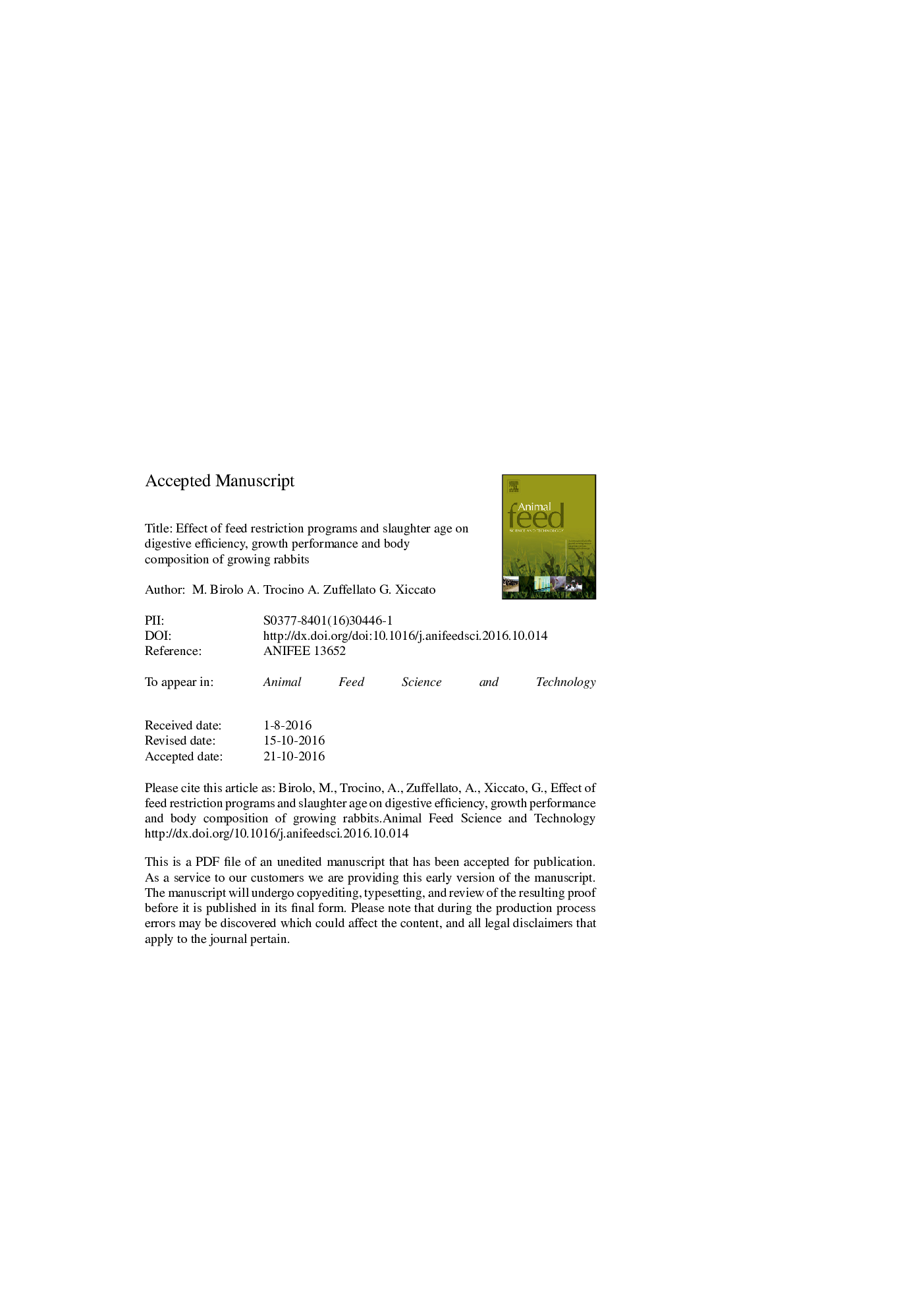| کد مقاله | کد نشریه | سال انتشار | مقاله انگلیسی | نسخه تمام متن |
|---|---|---|---|---|
| 5538834 | 1552364 | 2016 | 20 صفحه PDF | دانلود رایگان |
عنوان انگلیسی مقاله ISI
Effect of feed restriction programs and slaughter age on digestive efficiency, growth performance and body composition of growing rabbits
ترجمه فارسی عنوان
تأثیر برنامه های محدود کننده غذا و سن کشتاری بر راندمان گوارش، عملکرد رشد و ترکیب بدن رشد خرگوش ها
دانلود مقاله + سفارش ترجمه
دانلود مقاله ISI انگلیسی
رایگان برای ایرانیان
کلمات کلیدی
aNDFRMSEEREADFCTTADacid detergent fibre - الیاف پاک کننده اسیدEpizootic Rabbit Enteropathy - انتروپاتی خرگوش اپیزوDigestible energy - انرژی قابل هضمNitrogen excretion - دفع نیتروژنRoot mean square error - ریشه میانگین خطای مربعcoefficient of total tract apparent digestibility - ضریب هضم ظاهری کل دستگاهdry matter - ماده خشکFeed restriction - محدودیت خوراکNutrient digestibility - هضم مواد مغذیSlaughter weight - وزن کشتdigestible protein - پروتئین قابل هضمCarcass quality - کیفیت لاشه
موضوعات مرتبط
علوم زیستی و بیوفناوری
علوم کشاورزی و بیولوژیک
علوم دامی و جانورشناسی
چکیده انگلیسی
The effects of the feeding system (ad libitum vs. restricted) and the restriction programs (daily vs. weekly base) were evaluated on 300 commercial crossbred rabbits housed individually from weaning (37 d) until slaughter (at 73 d and 80 d of age). During the first three weeks, restricted rabbits received from 85% to 100% of the ad libitum intake according to two feeding curves with daily (+4Â g/d; D group) or weekly increments (+22Â g/week on average; W group). In the restriction period, the feeding system affected CTTAD of crude protein (+2.4% in restricted compared ad libitum rabbits; PÂ <Â 0.01). After restriction, dry matter (PÂ =Â 0.10), ether extract (PÂ =Â 0.03) and ADF (PÂ =Â 0.05) CTTAD were lower in previously restricted rabbits compared to those always fed ad libitum. During the first period, feed restriction reduced daily weight gain (â7.5%; PÂ <Â 0.01), feed intake (â7.1%; PÂ <Â 0.001), empty body lipid (â12.7%; PÂ =Â 0.03) and energy (â5.2%; PÂ <Â 0.01) contents compared to ad libitum feeding. In the second period, previously restricted rabbits showed higher daily weight gain (+8.7%; PÂ =Â 0.02), lower feed conversion (â6.0%; PÂ =Â 0.03), besides higher empty body lipid (+16.0%; PÂ <Â 0.01) and energy (+6.6%; PÂ <Â 0.01) contents compared to rabbits fed ad libitum. In the whole trial, feed restriction reduced mortality (20.7% vs. 8.7%; PÂ <Â 0.01) and tended (PÂ <Â 0.10) to reduce feed intake (142 vs. 139Â g/d), feed conversion (3.10 vs. 3.05) as well as N retention (53.6Â g vs. 51.9Â g). The restriction program had no effects during the restriction period. In the re-feeding period, rabbits submitted to the week-by-week restriction exhibited higher weight gain (PÂ <Â 0.01) and feed intake (PÂ =Â 0.02) and lower feed conversion (PÂ =Â 0.01) compared to those restricted on a daily base. In the whole trial, W rabbits showed higher feed consumption (PÂ =Â 0.04) and N excretion (PÂ =Â 0.05) than D rabbits. A later slaughter age increased final live weight (+8%; PÂ <Â 0.001) and feed conversion (+11%; PÂ <Â 0.001), dressing out percentages, dissectible fat, and hind leg muscle to bone ratio, empty body lipid (+13%; PÂ =Â 0.02) and energy contents (+4.2%; PÂ =Â 0.03), besides body N retention (+11%) and excretion (+32%) (PÂ <Â 0.001). In conclusion, regardless from the restriction program, a mild feed restriction (93% of ad libitum) during the first period improved rabbit health status and reduced environmental pollution in the fattening sector without impairing growth performance, slaughter results and carcass traits.
ناشر
Database: Elsevier - ScienceDirect (ساینس دایرکت)
Journal: Animal Feed Science and Technology - Volume 222, December 2016, Pages 194-203
Journal: Animal Feed Science and Technology - Volume 222, December 2016, Pages 194-203
نویسندگان
M. Birolo, A. Trocino, A. Zuffellato, G. Xiccato,
